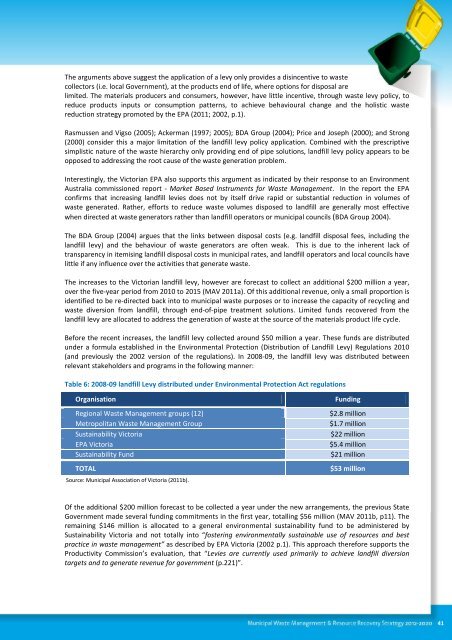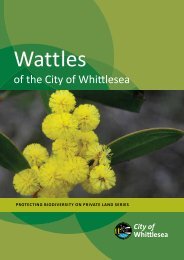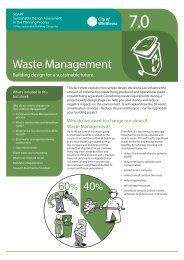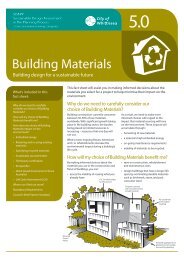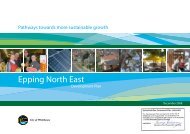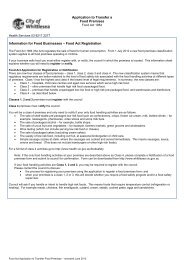Waste Management Strategy - full version - City of Whittlesea
Waste Management Strategy - full version - City of Whittlesea
Waste Management Strategy - full version - City of Whittlesea
Create successful ePaper yourself
Turn your PDF publications into a flip-book with our unique Google optimized e-Paper software.
The arguments above suggest the application <strong>of</strong> a levy only provides a disincentive to wastecollectors (i.e. local Government), at the products end <strong>of</strong> life, where options for disposal arelimited. The materials producers and consumers, however, have little incentive, through waste levy policy, toreduce products inputs or consumption patterns, to achieve behavioural change and the holistic wastereduction strategy promoted by the EPA (2011; 2002, p.1).Rasmussen and Vigso (2005); Ackerman (1997; 2005); BDA Group (2004); Price and Joseph (2000); and Strong(2000) consider this a major limitation <strong>of</strong> the landfill levy policy application. Combined with the prescriptivesimplistic nature <strong>of</strong> the waste hierarchy only providing end <strong>of</strong> pipe solutions, landfill levy policy appears to beopposed to addressing the root cause <strong>of</strong> the waste generation problem.Interestingly, the Victorian EPA also supports this argument as indicated by their response to an EnvironmentAustralia commissioned report - Market Based Instruments for <strong>Waste</strong> <strong>Management</strong>. In the report the EPAconfirms that increasing landfill levies does not by itself drive rapid or substantial reduction in volumes <strong>of</strong>waste generated. Rather, efforts to reduce waste volumes disposed to landfill are generally most effectivewhen directed at waste generators rather than landfill operators or municipal councils (BDA Group 2004).The BDA Group (2004) argues that the links between disposal costs (e.g. landfill disposal fees, including thelandfill levy) and the behaviour <strong>of</strong> waste generators are <strong>of</strong>ten weak. This is due to the inherent lack <strong>of</strong>transparency in itemising landfill disposal costs in municipal rates, and landfill operators and local councils havelittle if any influence over the activities that generate waste.The increases to the Victorian landfill levy, however are forecast to collect an additional $200 million a year,over the five-year period from 2010 to 2015 (MAV 2011a). Of this additional revenue, only a small proportion isidentified to be re-directed back into to municipal waste purposes or to increase the capacity <strong>of</strong> recycling andwaste di<strong>version</strong> from landfill, through end-<strong>of</strong>-pipe treatment solutions. Limited funds recovered from thelandfill levy are allocated to address the generation <strong>of</strong> waste at the source <strong>of</strong> the materials product life cycle.Before the recent increases, the landfill levy collected around $50 million a year. These funds are distributedunder a formula established in the Environmental Protection (Distribution <strong>of</strong> Landfill Levy) Regulations 2010(and previously the 2002 <strong>version</strong> <strong>of</strong> the regulations). In 2008-09, the landfill levy was distributed betweenrelevant stakeholders and programs in the following manner:Table 6: 2008-09 landfill Levy distributed under Environmental Protection Act regulationsOrganisationRegional <strong>Waste</strong> <strong>Management</strong> groups (12)Metropolitan <strong>Waste</strong> <strong>Management</strong> GroupSustainability VictoriaEPA VictoriaSustainability FundTOTALSource: Municipal Association <strong>of</strong> Victoria (2011b).Funding$2.8 million$1.7 million$22 million$5.4 million$21 million$53 millionOf the additional $200 million forecast to be collected a year under the new arrangements, the previous StateGovernment made several funding commitments in the first year, totalling $56 million (MAV 2011b, p11). Theremaining $146 million is allocated to a general environmental sustainability fund to be administered bySustainability Victoria and not totally into “fostering environmentally sustainable use <strong>of</strong> resources and bestpractice in waste management” as described by EPA Victoria (2002 p.1). This approach therefore supports theProductivity Commission’s evaluation, that “Levies are currently used primarily to achieve landfill di<strong>version</strong>targets and to generate revenue for government (p.221)”.41


